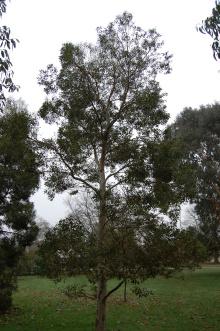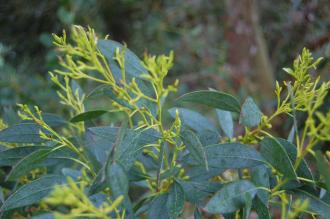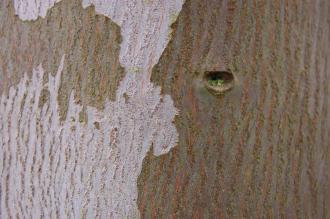
Eucalyptus archeri (06/01/2013, Kew Gardens, London)
Position: Full sun
Flowering period: Summer
Soil: Moist, well drained
Eventual Height: 12m
Eventual Spread: 10m
Hardiness: 7a – 11
Family: Myrtaceae
Eucalyptus archeri is an evergreen tree with an upright, open habit. As with most Eucalyptus trees it produces both juvenile and mature forms of its leaves which are fragrant when crushed. The juvenile are grey/ green, rounded with entire pink margins, up to 4cm long. Its blue/ green adult leaves are lanceolate with entire margins up to 9cm long and 3cm broad. Its white/ gray bark is smooth and peels to reveal pinks, greys, white and browns in a mosaic pattern. Its white flowers are umbles and appear in clusters of three.
Eucalyptus archeri, commonly known as the Alpine Cider Gum, Apple Cider Gum or Archer’s Alpine Gum, is native to south east Australia, Tasmania.

Eucalyptus archeri Leaf (06/01/2013, Kew Gardens, London)
The etymological root of the binomial name Eucalyptus is derived from the Greek eu meaning ‘good‘ and kalyptos meaning ’covered’ referring to the calyx which forms a lid over the flowers when in bud. Archeri is named after William Archer (1829 – 1874), discoverer of this tree and fellow of the Royal Society and the Linnean Society.
The landscape architect may find Eucalyptus archeri useful as a relatively compact evergreen tree with silver foliage. This tree is tolerant of maritime conditions.
Ecologically, Eucalyptus archeri is attractive to pollinating insects.

Eucalyptus archeri Bark (06/01/2013, Kew Gardens, London)
Eucalyptus archeri prefers moist, fertile, well-drained soils. It prefers a neutral to acid pH of soil.
Eucalyptus archeri requires little maintenance. This tree is suitable for coppicing, this encourages the growth of the attractive juvenile foliage.

